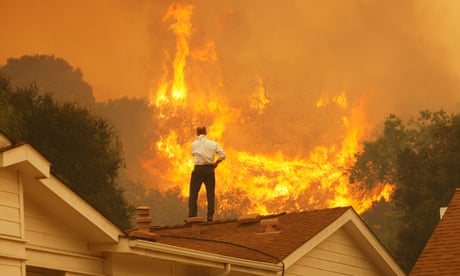- by foxnews
- 23 May 2025
Revealed: how climate breakdown is supercharging toll of extreme weather
Revealed: how climate breakdown is supercharging toll of extreme weather
- by theguardian
- 05 Aug 2022
- in news

The devastating intensification of extreme weather is laid bare today in a Guardian analysis that shows how people across the world are losing their lives and livelihoods due to more deadly and more frequent heatwaves, floods, wildfires and droughts brought by the climate crisis.
Flooding, July 2021
This mapping and analysis of climate catastrophes has never been more relevant. Already in 2022, the climate crisis has rampaged around the planet, bringing the reality of global heating into the homes of billions and to the top of news bulletins. Record-breaking heat has hit North America, Europe, China, India and Pakistan, sparking wildfires in many places. Terrible floods have swept Australia, Bangladesh and South Africa. In due course, scientists will firmly link many of these to global heating, as they did for the fiery northern hemisphere summer of 2018.
Attribution studies have so far assessed only a small fraction of extreme weather events, with particularly concerning gaps in the global south, which is least responsible for the climate crisis but home to many of the people most vulnerable to its effects.
But the following is what we know for sure about how much human-caused climate change is to blame for supercharging extreme weather, where it has already hit, and what it has cost us in lives and damage. It is a sobering reckoning of how deeply the climate crisis has already cut into societies and how desperate the need is to stop further deterioration.
Scientists calculate this by using weather records and computer models to compare two worlds. One is the world we are in, heated by our carbon emissions. The other is the world before the mass burning of fossil fuels and rising temperatures. Researchers assess how frequent a specific extreme weather event is in both worlds. If it is more intense or more frequent in our heated world, then the footprint of global heating is clear.
Heatwave, May 2022
The most striking single finding of the Guardian analysis of the attribution studies is the identification of at least a dozen major extreme events that would have been wildly improbable without human-caused global heating.
Heatwave, July 2018
Counting the toll of the climate crisis begins with deaths, and scientists are just starting to be able to directly link human-caused climate change to human fatalities.
In the worst-affected cities, hundreds of people a year on average are already dying from this extra heat, including in São Paulo (239 deaths), Athens (189), Madrid (177), Tokyo (156), Bangkok (146) and New York (141). The study covered 732 locations in 43 nations; a lack of data limited wider coverage. It is tricky to extrapolate these findings to a global figure, but a rough estimate given by the scientists is more than 100,000 deaths a year. Over decades, that implies a toll of millions of lives.
Some places are being hit especially hard. About three-quarters of heat deaths in Ecuador, Colombia, Guatemala and Peru result from human-caused global heating, far above the 37% average in the study. This is a consequence of especially rapid heating in these regions combined with the high vulnerability of poorer people.
About 66% of heat deaths in Kuwait and Iran are also attributed to the climate crisis, while in Norway the proportion is almost 50%. Southern Europe has a high number of deaths owing to an elderly population and the rapidly rising frequency of heatwaves.
The grim toll of human-caused global heating on children was revealed in a study that found it had killed 7,000 to 11,000 children under five every year for the last decade in sub-Saharan Africa. The level of heat-related child deaths was double what it would have been without climate change, the researchers said.
Prof Dann Mitchell, of the University of Bristol, UK, warned that countries lacking the health data needed for such studies were often among the poorest and most vulnerable, and, worryingly, also major hotspots of rapid population growth, such as India and Nigeria.
The number of global heating deaths caused by more complex extreme weather is trickier to assess. But the increased intensity of Hurricane Maria due to human-induced climate change led to the deaths of up to 3,670 people in 2017, according to one study.
Hurricane Harvey, August 2017
Global heating unsurprisingly has a global impact. But the impact of extreme weather is felt locally, by each community, for which global heating has loaded the dice of disaster.
Records were also shattered by the downpours that caused fatal flooding across Germany and Belgium in July 2021, killing at least 243 people. Those rains were found to have been made up to nine times more likely by global heating.
In the US, Texas suffers frequently. But, more than a decade ago in 2011, when the then governor, Rick Perry, was falsely accusing climate scientists of manipulating data, there was an exceptionally hot summer, found to have been made 10 times more likely by global heating.
Heatwave, July 2021
Global heating supercharged the super typhoon Haiyan, which battered the Philippines in 2013, pushing up a storm surge that sent ocean water crashing inland by 20%, killing 7,000 people.
China in particular is enduring a rollercoaster of extreme weather made worse by global heating. Exceptional rains at the start of 2019 were made 30% more likely and blocked out the sun in the Middle-Lower Yangtze Plain, cutting sunshine hours by 57% and reducing rice production.
The Arabian Gulf, which may face unsurvivable conditions in future, appears to have been barely assessed by attribution studies.
Australia may until recently have had a government that had little concern for the climate crisis, but the climate crisis remains an extraordinary concern for Australia.
Marine heatwave, March 2016
Drought, 2015
But few other attribution studies have been done in Latin America, home to 650 million people. One found the fingerprints of global heating on a severe drought in the southern Amazon in 2010. The subsequent die-off of trees, and stunted growth of others, resulted in 4bn more tonnes of CO2 in the atmosphere, roughly equivalent to the annual emissions of the European Union.
Even more temperate parts of South America have been affected. In December 2013, Argentina endured a heatwave made five times more likely by global heating, and in 2017 major floods in Uruguay were made more likely by the same factor.
The science of attribution has delivered a bleak but undeniable picture of how global heating is already bringing death and destruction. But what about the future?
- by foxnews
- descember 09, 2016
United Airlines flight returns to Hawaii after concerning message found on bathroom mirror; FBI investigating
United Airlines Flight 1169 to Los Angeles returned to Hawaii after a "potential security concern" aboard the plane. The FBI and police are investigating.
read more


